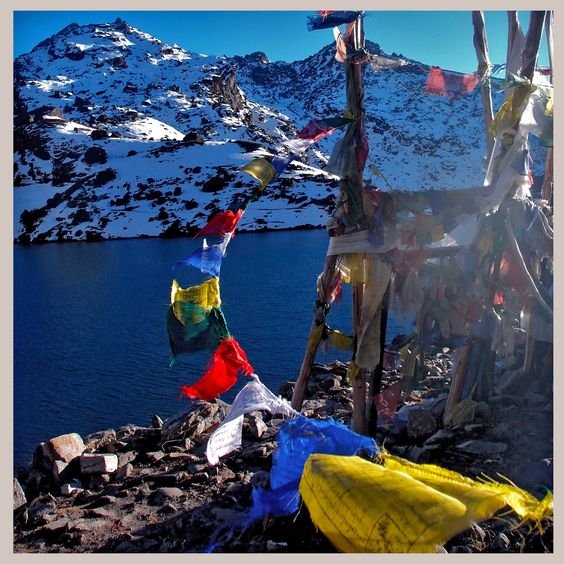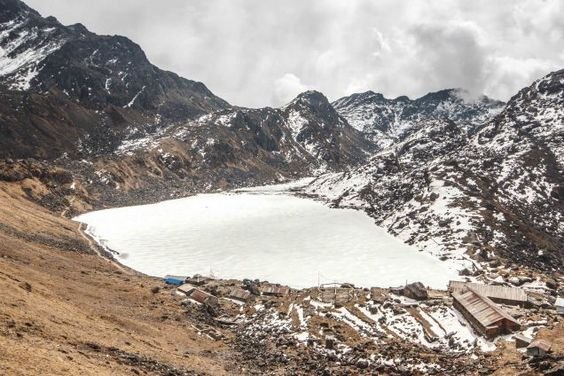Nestled high in the majestic Langtang National Park of Nepal, Gosaikunda Lake is a breathtaking alpine gem that holds immense religious and natural significance. Situated at an altitude of 4,380 meters (14,370 feet), this pristine glacial lake is a pilgrimage site revered by both Hindus and Buddhists. Surrounded by snow-capped peaks, lush forests, and cascading waterfalls, Gosaikunda Lake offers a serene and awe-inspiring retreat, enticing trekkers and devotees alike to experience its tranquil beauty and spiritual ambiance.
Gosaikunda Lake holds deep religious significance for Hindus and Buddhists. According to Hindu mythology, the lake is believed to be the abode of Lord Shiva, the deity of destruction and transformation. It is believed that Lord Shiva created the lake by thrusting his trident into the ground to quench his thirst. Each year during the sacred festival of Janai Purnima, devotees embark on a pilgrimage to Gosaikunda Lake to bathe in its holy waters and pay homage to Lord Shiva. The lake is also associated with the story of Lord Vishnu, who is said to have created the lake by digging with his weapon. Buddhists believe that Gosaikunda Lake is a sacred place associated with Guru Rinpoche (Padmasambhava), a revered figure in Tibetan Buddhism.
Beyond its religious significance, Gosaikunda Lake is a natural wonder that captivates visitors with its ethereal beauty. Surrounded by rugged mountain peaks, including Langtang Lirung and Ganesh Himal, the lake’s crystal-clear waters shimmer with a pristine blue hue, reflecting the towering summits and pristine sky above. The surrounding landscape boasts lush alpine meadows, rhododendron forests, and cascading waterfalls, creating a picturesque backdrop for the tranquil lake. The diverse flora and fauna of the region, including rare orchids and Himalayan wildlife, add to the enchanting ambiance. As trekkers ascend to Gosaikunda Lake, they are rewarded with panoramic views and an overwhelming sense of peace and serenity.
The journey to Gosaikunda Lake is as remarkable as the destination itself. The trek typically begins in Dhunche or Syabrubesi and takes trekkers through breathtaking landscapes, remote villages, and lush forests. The trail gradually ascends, offering glimpses of snow-capped peaks and traditional Tamang and Sherpa settlements. The final ascent to Gosaikunda Lake is a challenging yet rewarding experience, where trekkers are greeted by the sparkling expanse of the sacred lake. Along the trekking route, tea houses and lodges provide comfortable accommodation and warm hospitality, ensuring a memorable experience for all who undertake this spiritual and natural pilgrimage.
Recognizing the ecological importance of Gosaikunda Lake and its surroundings, the Nepalese government, along with local communities, has implemented conservation efforts to protect the area’s delicate ecosystem. Langtang National Park safeguards the region’s biodiversity and ensures sustainable tourism practices. Visitors are encouraged to follow responsible trekking guidelines, including proper waste management and respecting the cultural and natural heritage of the area. These preservation efforts aim to maintain the purity and sanctity of Gosaikunda Lake for future generations to enjoy.
Gosaikunda Lake stands as a testament to the harmony between spirituality and nature. Its serene waters and majestic surroundings inspire awe and reverence, drawing both devotees and adventurers to its sacred shores. As trekkers embark on the journey to Gosaikunda Lake, they are immersed in the ethereal beauty of the Himalayas, where ancient traditions and pristine landscapes converge. Gosaikunda Lake is not only a destination of natural splendor but also a gateway to spiritual reflection, offering a profound and transformative experience for all who seek its tranquil embrace.
Trekking in Langtang region
Group size of the Trek
Minimum one person
Maximum 15 person
Trek features :
- Famous pilgrimage site for Hindus & buddhist
- spectacular mountain views of Langtang ranges
- Rhododendron flowers forest, many types of orchids
- Cheese factory on the way
- Tamang culture & practices.
Grade : Medium/ Hard
Elevation: Max. 4460 Meters. (Gosaikunda lake)
Accommodation : Tea House
Food: Continental
Equipment List
The requirement of equipment is diffrent for each trek. these are common requirment of personnel things for most of our treks. Please feel free to ask for advice we will provide you the best suggestion.
Clothing and Equipment Check List
- Pair of T-shirts and half pants
- Fleece jacket and warm Trousers
- Raincoats & water proof pants
- Down jacket
- Thermal underwear
- Windproof jacket
- Fleece/wool warm hat
- Baseball hat or sun hat
- Snow & sun glasses
- Fleece gloves
- Socks – 3/4 pairs
- Socks- woolen
- Trekking shoes
- Ligh sport shoes
- Small rucksack for daypack
- Waterbottle (metal )
- Kit Bag medium size
- Trekking poles (optional)
- Sleeping bag down ( -5-10 degree)
- Flash light & batteries
Personal things
- Small kit bag (valuable things can put inside , pocket knife )
- Sun Cream & lip care cream
- Moist towels for personal hygiene
- LIst






